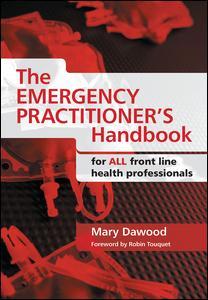The Emergency Practitioner's Handbook For All Front Line Health Professionals
Auteur : Dawood Mary

Date de parution : 05-2012
17.4x24.6 cm
Disponible chez l'éditeur (délai d'approvisionnement : 14 jours).
Prix indicatif 52,22 €
Ajouter au panierThèmes de The Emergency Practitioner's Handbook :
Mots-clés :
Relevant Past Medical History; Follow; Chronic; Fracture Clinic; Tendon; Displaced Fractures; Fb; NAI; Undisplaced Fracture; Head Injury; Broad Arm Sling; Avulsion Fracture; Sob; Supracondylar Fractures; Local Anaesthetic; ENT; Pop; Emergency Nurse Practitioners; Compartment Syndrome; Radial Nerve; Nerve Injuries; Brachial Artery; Clues; External Rotation; Ankle Injury



